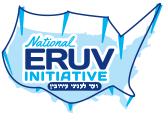Tips for Checking an Eruv
In this article, you will find practical and helpful tips to make checking an Eruv easier. If you have any tips, please share them with us and we will add them to the list.
Getting Around Your Eruv
- In America there is right turn on a red light. Also, we drive on the right side of the street. Hence, checking an eruv counterclockwise (making right turns) goes faster than clockwise (making left turns). This tip applies whenever a car is being used for eruv checking in any capacity.
- If you are having trouble seeing the eruv line, consider cleaning your car windows or cleaning your glasses. Additionally, getting new lenses with a new prescription may enable you to see the line clearer and/or from far away distances. Also, checking at a different time of daylight can be helpful.
- Cars with a sunroof allow for the checker to check through the sunroof. Convertibles allow for even more flexibility.
- Although very time consuming, the ideal way to check an eruv is by foot rather than by car. Ways to speed up checking an eruv by foot are to use rollerblades, having a driver (see next tip- tip 5) or a bicycle (if appropriate for the terrain). Rollerblades have an advantage that your hands are free, they are easy to transport, and they can be left on your feet if you need to get into a car. Bicycles have the advantage that they can go on grass or dirt. In any event, you should be as scrupulous in your checking on rollerblades or a bicycle as you would when walking.
- Having a driver drop you off and pick you up can help speed up checking, especially if they are familiar with the path of the eruv and know where to wait for the person(s) checking.
- Even with a driver, when checking an eruv by car you must be scrupulous when you are checking because things can be missed. Example: you could miss a gap in the lower portion of a chain link fence because it is at a place which is harder to notice when moving at the speed of the car.
Taking Pictures
- Always have a camera with you when you are checking an eruv. A camera with a good optical zoom can enable you to see things from far away (similar to binoculars). In addition, having a camera will enable you to take pictures of anything that you will want to ask a Rav.
- When using a camera to take pictures of problems or questions for a Rav, always take a picture of nearby landmarks to enable you to come back to the sight when needed and/or to describe to other members of the eruv checking/repair team where the site is. See next entry about smart phones.
- Smart phones have a technology to log all of your pictures on a map (with reasonably good precision) and log the longitude and latitude automatically (you can put coordinates into google maps). Make sure this feature is turned on on your smartphone. This technology will be very helpful. You know automatically exactly where anything you take a picture is located. This can prevent many communication complications later on and can ease the process of repairing the correct location. Smart phones are the preferred technology to be used. Even if you want to use your normal camera for pictures (because it has a better zoom, etc.) still use your smartphone and this technology. It is most helpful and saves you from remembering, or writing down locations or taking extra pictures of landmarks. (all of which are easily susceptible to error).
Miscellaneous
- Always have a tape measure with you when checking an eruv. In the event that you don’t have a tape measure, a normal size sheet of paper is 8.5 by 11 inches and can be easily used to measure. Try to take pictures of the measurements showing the measurements as well as what is being measured.
- Sometimes when checking an eruv, you are forced to strain your neck by frequently looking up at something while standing very close to what you are looking at (sometimes there is no other way). If you were to use a mirror (even some of the time), you could prevent straining your neck.


